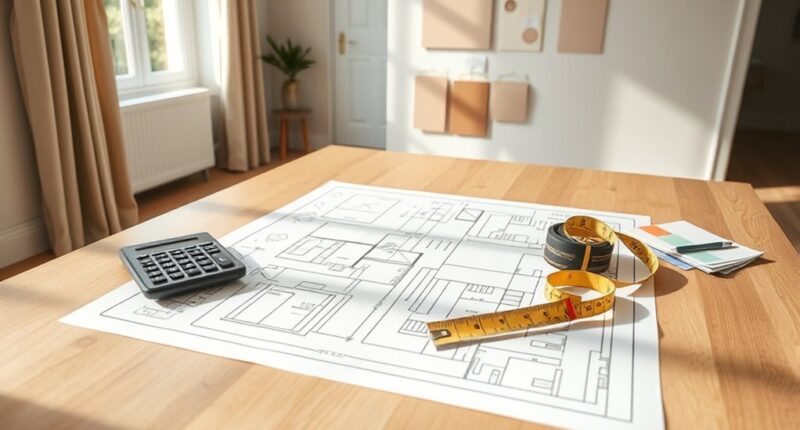To effectively budget a remodel, allocate detailed allowances based on market research to cover materials and fixtures, ensuring clear documentation and flexibility. Incorporate a contingency fund of 10-20% for unforeseen expenses, tracking costs diligently to prevent overruns. Prioritize quality by selecting durable, energy-efficient materials and negotiating prices to maximize value within your budget. Maintaining transparency with stakeholders helps manage expectations. Mastering these key elements will prepare you to handle unforeseen costs and optimize your investment.
Key Takeaways
- Establish clear allowances based on detailed research and market prices to allocate funds for materials and finishes.
- Allocate 10-20% of the total budget for a contingency fund to cover unforeseen expenses.
- Document allowances explicitly in contracts, specifying scope, quality, and potential adjustments.
- Track all expenditures meticulously to manage the contingency fund effectively and prevent scope creep.
- Prioritize durable, energy-efficient materials to maximize quality within the budget and reduce long-term costs.

Are you prepared to manage the costs effectively for your remodeling project? Success hinges on your ability to allocate funds accurately and anticipate potential expenses. Establishing clear allowances, a realistic contingency, and a focus on value are essential components of a sound budget. Allowances serve as designated amounts for specific materials, fixtures, or finishes, providing flexibility while maintaining control. When setting allowances, base them on detailed research and current market prices, ensuring they reflect quality standards and realistic costs. This approach prevents underfunding and reduces surprises during procurement. It’s critical to document allowances explicitly in your contract, specifying what they cover and the expected quality, so there’s no ambiguity later. Still, allowances shouldn’t be viewed as fixed; rather, they act as placeholders that can be adjusted if actual costs deviate, provided changes are documented and approved. Incorporating elements like natural materials and vintage decor can add authenticity and charm while staying within your budget.
A well-planned contingency fund is another safeguard against unforeseen expenses. Typically, allocating 10-20% of your total budget for contingencies is advisable, depending on the project’s complexity. This reserve covers surprises like hidden structural issues, material price fluctuations, or design modifications. The key is to view the contingency not as an optional addition but as an integral part of your financial plan. Maintaining transparency with contractors and suppliers about the contingency helps ensure it’s reserved for genuine unexpected costs, not used as a buffer for scope creep or poor planning. Track all expenditures meticulously, adjusting your contingency fund as the project progresses to maintain an accurate picture of remaining funds.
Valuing quality within your budget is equally crucial. While it’s tempting to cut costs, sacrificing quality can lead to higher expenses down the line due to repairs, replacements, or dissatisfaction. Prioritize durable, energy-efficient materials that provide long-term savings. When selecting fixtures, finishes, or appliances, compare options based on lifespan, maintenance costs, and warranties. This ensures you’re making informed decisions that balance initial investment with ongoing value. Additionally, negotiate with vendors to secure the best prices without compromising quality. Always keep an eye on your overall budget, making adjustments where necessary but never at the expense of essential quality standards.
Frequently Asked Questions
How Should I Set Realistic Allowances for Unexpected Costs?
You should research typical costs for each renovation element in your area and add a 10-20% buffer for unforeseen expenses. Consult with experienced contractors and suppliers to refine your estimates, ensuring allowances reflect current market prices. Regularly review and adjust these allowances as the project progresses, maintaining flexibility. This approach helps you stay within budget while accommodating unexpected costs without compromising quality or scope.
What Percentage of My Budget Should Be Allocated to Contingency Funds?
Think of your budget as a fortress, with a contingency fund as its shield. Allocating 10-20% of your total budget for contingencies guarantees you’re protected against unforeseen costs. This percentage varies depending on project complexity and scope. By reserving this essential shield, you maintain financial control, allowing flexibility and peace of mind. Be precise with your calculations, and adjust your contingency based on potential risks to keep your remodel secure.
How Do I Prioritize Spending When Budget Constraints Arise?
When budget constraints arise, prioritize essential elements like structural integrity, safety features, and core functionalities first. Allocate funds to critical aspects before considering upgrades or aesthetic enhancements. Review your project scope and identify non-negotiable items versus luxuries. Communicate transparently with your contractor to explore cost-saving options. Flexibility and clear prioritization ensure you meet your most crucial needs without compromising quality or safety.
Can Allowances Be Adjusted Mid-Project if Costs Change?
Yes, allowances can be adjusted mid-project if costs change, but you should discuss this with your contractor promptly. They’ll review the new estimates and determine if the allowance can be increased or modified without disrupting the overall budget. Keep in mind, adjusting allowances might affect contingency funds and project timelines, so guarantee you have clear communication and documentation to avoid surprises or misunderstandings later on.
What Strategies Minimize Budget Overruns During Remodeling?
You can minimize budget overruns by setting a detailed scope and sticking to it. Regularly monitor progress and costs, adjusting allowances only when necessary. Prioritize transparent communication with contractors to catch issues early. According to industry data, projects with proactive oversight see 30% fewer budget overruns. Using fixed-price contracts and contingency funds also helps control unexpected expenses, ensuring your remodel stays within budget.
Conclusion
Think of your remodel budget as a carefully plotted course through uncharted waters. By setting clear allowances, allocating a contingency, and valuing each detail, you navigate potential storms with confidence. Staying vigilant and adaptable guarantees your project remains on course, preventing surprises from capsizing your plans. With meticulous planning, you’ll steer your renovation smoothly from start to finish, transforming a complex journey into a well-charted voyage toward your dream space.









